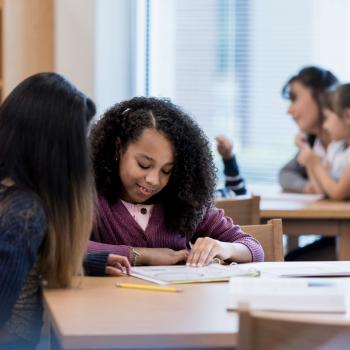Peer Review

About this Strategy Guide
This strategy guide explains how you can employ peer review in your classroom, guiding students as they offer each other constructive feedback to improve their writing and communication skills.
Research Basis
Peer review refers to the many ways in which students can share their creative work with peers for constructive feedback and then use this feedback to revise and improve their work. For the writing process, revision is as important as drafting, but students often feel they cannot let go of their original words. By keeping an audience in mind and participating in focused peer review interactions, students can offer productive feedback, accept constructive criticism, and master revision. This is true of other creative projects, such as class presentations, podcasts, or blogs. Online tools can also help to broaden the concept of “peers.”
Real literacy happens in a community of people who can make meaningful connections. Peer review facilitates the type of social interaction and collaboration that is vital for student learning.
Strategy in Practice
Peer review can be used for different class projects in a variety of ways:
- Teach students to use these three steps to give peer feedback: Compliments, Suggestions, and Corrections (see the Peer Edit with Perfection! Handout). Explain that starting with something positive makes the other person feel encouraged. You can also use Peer Edit With Perfection Tutorial to walk through the feedback process with your students.
- Provide students with sentence starter templates, such as, “My favorite part was _________ because __________,” to guide students in offering different types of feedback. After they start with something positive, have students point out areas that could be improved in terms of content, style, voice, and clarity by using another sentence starter (“A suggestion I can offer for improvement is ___________.”). The peer editor can mark spelling and grammar errors directly on the piece of writing.
- Teach students what constructive feedback means (providing feedback about areas that need improvement without criticizing the person). Feedback should be done in an analytical, kind way. Model this for students and ask them to try it. Show examples of vague feedback (“This should be more interesting.”) and clear feedback (“A description of the main character would help me to imagine him/her better.”), and have students point out which kind of feedback is most useful. The Peer Editing Guide offers general advice on how to listen to and receive feedback, as well as how to give it.
- For younger students, explain that you need helpers, so you will show them how to be writing teachers for each other. Model peer review by reading a student’s piece aloud, then have him/her leave the room while you discuss with the rest of the class what questions you will ask to elicit more detail. Have the student return, and ask those questions. Model active listening by repeating what the student says in different words. For very young students, encourage them to share personal stories with the class through drawings before gradually writing their stories.
- Create a chart and display it in the classroom so students can see the important steps of peer editing. For example, the steps might include: 1. Read the piece, 2. Say what you like about it, 3. Ask what the main idea is, 4. Listen, 5. Say “Add that, please” when you hear a good detail. For pre-writers, “Add that, please” might mean adding a detail to a picture. Make the chart gradually longer for subsequent sessions, and invite students to add dialogue to it based on what worked for them.
- Incorporate ways in which students will review each other’s work when you plan projects. Take note of which students work well together during peer review sessions for future pairings. Consider having two peer review sessions for the same project to encourage more thought and several rounds of revision.
- Have students review and comment on each other’s work online using Nicenet, a class blog, or class website.
- Have students write a class book, then take turns bringing it home to read. Encourage them to discuss the writing process with their parents or guardians and explain how they offered constructive feedback to help their peers.
Using peer review strategies, your students can learn to reflect on their own work, self-edit, listen to their peers, and assist others with constructive feedback. By guiding peer editing, you will ensure that your students’ work reflects thoughtful revision.